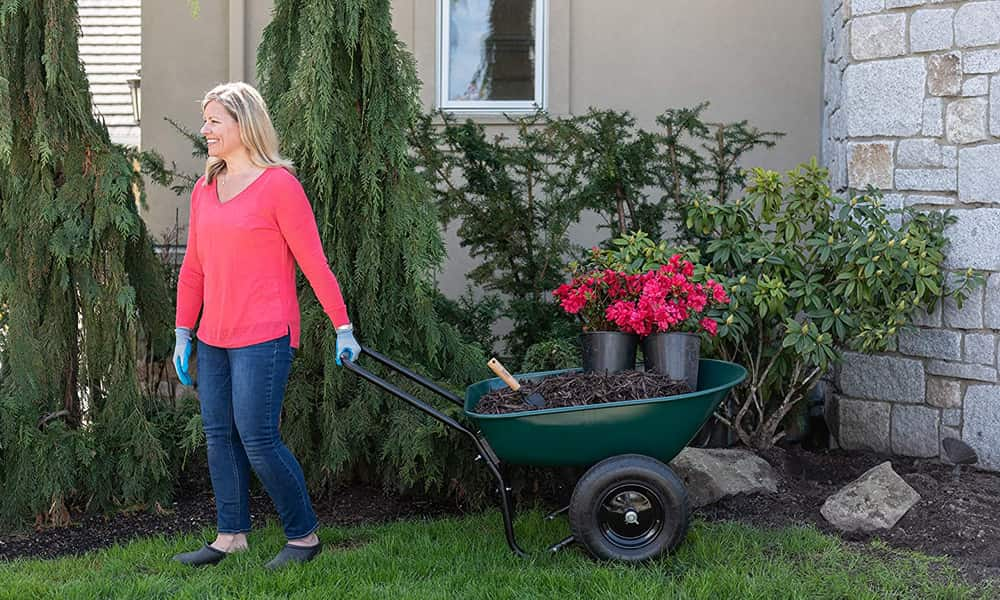Are Dual-Wheel Wheelbarrows Preferred Over Singular Ones?

A good-quality wheelbarrow will save you tons of time and effort while allowing you to avoid back pain from lifting and transporting heavier loads. When you’re on the market for wheelbarrows, you’ll come across a variety of choices and not all of them are going to look the same.
You’ll find ones made of steel and others of plastic; you’ll come across different handle types and tire styles; you’ll also have to make a decision between single-wheeled ones and two-wheeled ones. The best one for you depends mostly on what you intend to use it for. Here’s a short guide to help you make an informed purchase.
SINGLE-WHEELED WHEELBARROWS VS. DUAL-WHEEL WHEELBARROWS
Single-wheeled wheelbarrows
The single-wheeled wheelbarrow is the traditional wheelbarrow that has (as you can guess by its name) one wheel at the front. This kind of wheelbarrow is a little more difficult to manage when you’re transporting heavy loads because it can be challenging to steer. Especially if the weight you’re carrying isn’t evenly distributed, you’re going to have trouble pushing and controlling it.
An upside of using one of these is that they have a good turning capacity thanks to the single wheel at the front, which makes it pretty easy to maneuver in smaller spaces.
Dual-wheeled wheelbarrows
The dual-wheel design is preferred for wheelbarrows because it adds to the stability as you’re pushing around a heavy load. Especially when you’re transporting large bags of things like wood, mulch, or bricks, the dual-wheeled wheelbarrow will serve you well. It won’t topple and it will be easy to control.
The only downside of these kinds of wheelbarrows is that it can be slightly challenging to steer them through smaller spaces because of their limited turning capacity. They are also significantly more expensive than single-wheeled ones.
WHY DUAL-WHEELED WHEELBARROWS ARE BETTER
Dual-wheeled wheelbarrows are overall a lot more stable thanks to the two wheels and handles. This makes them safer and easier to carry heavy loads because you don’t have to constantly worry about the barrow tipping over to one side. The extra wheel provides you with extra balance while pushing.
Thanks to the added balance and stability, you can easily carry heavier loads with this kind of barrow. It also doesn’t need the weight of the load inside it to be equally distributed; you can simply toss in the things you need to transport however you want.
This kind is also a lot more versatile in its usage and operable with a single hand.
OTHER FACTORS TO CONSIDER WHEN BUYING A WHEELBARROW
Material
Plastic wheelbarrows are a lot lighter than metal ones, but they aren’t as durable as metal ones. They are also not suitable for carrying heavier loads.
Handles
Curved handlebars are the most common and the most preferred kinds of handles on wheelbarrows. Two handles are better than one because they offer better control and more comfort while pushing. If you’re looking for even more convenience, you should look for a hook of some sort near the handles that can double as a trash bag or even a storage bin for your tools.
Wheels
- Plastic
Plastic wheels are non-pneumatic, flat-free, lightweight, and durable. They are also budget-friendly but don’t provide shock absorption. They are better suited for when you need to use your wheelbarrow on softer ground and aren’t looking for an extremely high weight capacity.
- Rubber
Most wheelbarrows will have rubber wheels. They can fall into any one of three categories: non-pneumatic, semi-pneumatic, and non-pneumatic. The non-pneumatic ones are solid and flat-free but do not provide shock absorption. They are better suited for transporting lighter loads. Semi-pneumatic ones offer pretty decent shock absorption and are flat-free as well. They are best suited for wheelbarrows that are intended for use on even, uneven, or rough ground. Finally, the pneumatic ones are super sturdy and air-filled.